- Che valenza ha questo tuo nuovo lavoro in rapporto alla situazione presente, cioè come questa tua pratica può essere da te considerata un riflesso o meno di questo momento?
I think, at the heart of my new project, there is a rejection and a non-reflection of this particular moment that exists, seemingly as if framed, within a wider moment that is perhaps reflected on us, our lives, our plane, our surface, by the sun which seems to me to be alive and a healer and a destroyer and capable of creating life, light, timelines, shadows, etc. I know that looking at the sun in art is age old (especially in mythology and ancient cosmologies) but I am not sure that looking at the ways we ask the sun to mark our lives and guide us to prosperity and pleasure as well as protect us as we ascend through daily life (up and down) has been creatively examined enough. I live in Florida. It is bright. It is esoteric. It is called the Sunshine State. (TSE original text)
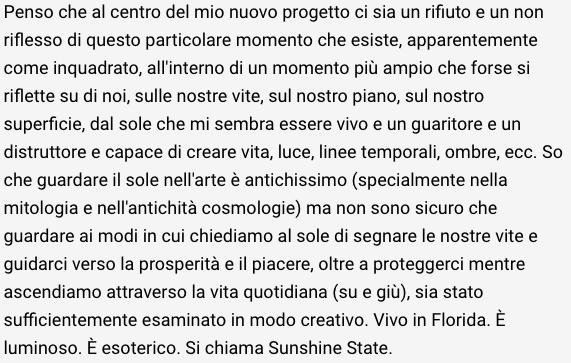
- Che cosa rappresenta, come si inserisce e come riconosci ciò che stai facendo all’interno del tuo percorso: è continuità , è revisione, è novità, è ritorno al passato, è innovazione. Quali sono le connessioni eventuali con il tuo lavoro precedente. Ci sono attinenze o referenti. Magari proprio un uso di materiali diversi, riscoperti, o di diverse tecniche, o diverse visioni concettuali?
It represents a walk into light, an attempt at an exploration at what those who have walked into light (light beings) want from us. I am asking the camera if it can help me find another us and the influence on us of solar intentions. We know what we require of the sun but (as a living being) what does it require of us? I think it was Gurdjieff who said, “We are food for the moon.” Well what is he got it wrong or only half right? What if we are drink for the sun?
It has to be a form of continuity––whatever the path. I would say it is a return to film photography but I never really left film photography. I could also say that it’s a return, for the most part, to Color Photography but that would be a little deceptive too because every black and white image is pulled from the world of color. Or are we black and white blind in the same way that some people are color blind? Certainly, I am using film and its reusability to make the world meet the world, to touch itself, and to examine via lens and eye, the differences between sunlight and daylight.
I am asking the camera if they are the same (or different apps) and allowing the images to be the answers. If my materials have changed it maybe because I have adopted the old method of recycling the roll of film (through the camera) with a different lens (often) each time, sometimes two, three and four times. All subject matter is material thus all material has the potential to become subject matter when any form of an eye-apparatus is involved. It reminds me, just a bit, of collage, but for me it’s more fluid, no scissors, no incisions. Light is the surgeon, the artist. I call it Simultaneous Sight. I am trying to re-reveal what’s obviously not so obvious, reveal what’s hidden and occult and allow a matrimony of the two to emerge. It is the only way I know how to trick the existing realities, languages and symbols to continue themselves in a new form, format or form of matter. The image, the I Am Age, lives and the images are the lives.
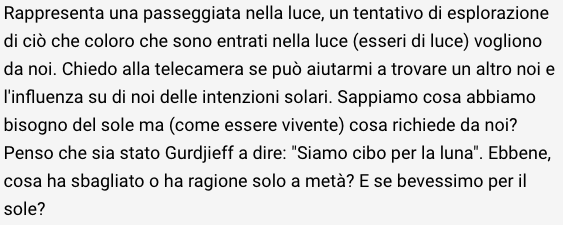
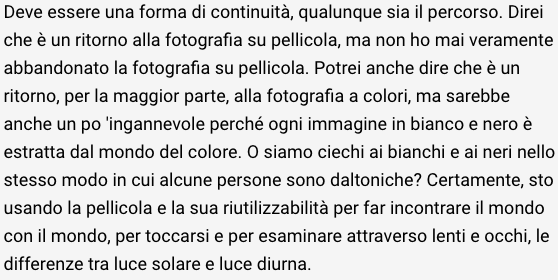
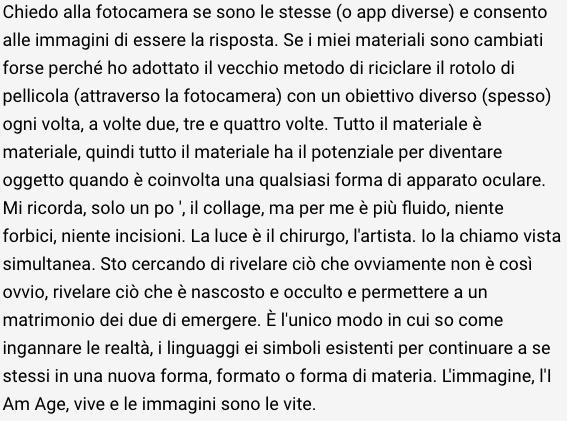
- Cosa pensi del tuo lavoro di oggi nel contesto che stiamo vivendo, in rapporto al presente e al più prossimo domani. In particolare cioè come pensi possa agire il tuo lavoro sull’oggi, ne vedi un’azione in rapporto a questo contesto particolare e magari anche alla realtà di esistenza modificata che sembra prospettarsi in futuro?
Many people here, in America (specifically Black America) are awaking to the possibility that we are not being told the whole story about what is happening in America (and in the world) and what has happened in our lives and in history. For reasons I cannot explain people are having conversations about new narratives and new historical timelines that have either been inserted into the past and present or that were already there but hidden. These narratives are creative (camera-like), eye-opening (aperture-like) , far-reaching (focal length-like), and reality altering (photography-like) but they also express (perhaps) the evidence of one world layered on top of another, one we can see and one that we cannot and I am not just hinting at the existence of a spiritual realm but instead an accessibility to source, sun, projector, energy that is as multiple and diverse as the experiences of all of humankind. Imagine all of the cameras (on earth or in earth) taking a photograph all at once, a photograph that we can see or live in.
Is that what happens, metaphorically and daily, with the sun? We know that our year is the equivalent of a day to the sun but we are also just beginning to question whether or not daylight and sunlight are the same thing in the same way that photography has long since had to consider the different qualities of available light and flash. If there is to be a new healing (post Covid), it must also include an advanced mental perspective but not an overly external technical one such as the gods (and tools) of photography A.I. would impose.
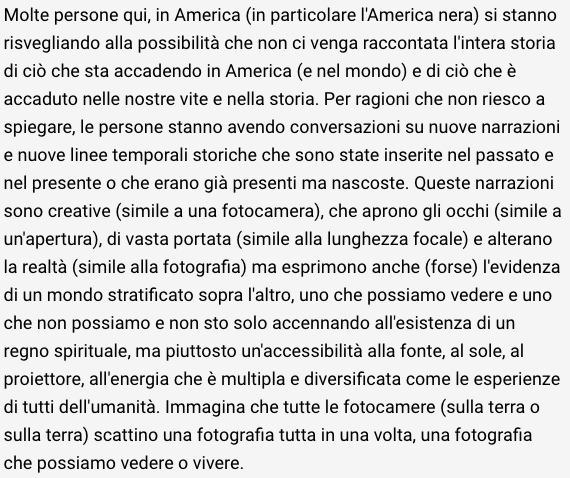
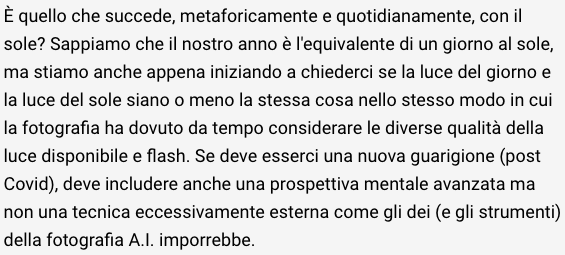
- Che influenza ha avuto o potrebbe avere questo tuo lavoro sulla tua consapevolezza di essere artista in rapporto oltre al tuo privato contesto esistenziale, in rapporto con il mondo in generale?
It is hard to tell if I am influenced by my work or if it is influenced by me. Society has an instant (one size fits all) way of making the work and the artist one singular entity, identifiable and packaged for the viewer––by the muse to the museum. The artist, too, begins to see his or herself in themes, parenthesis, styles, categories, exhibitions, retrospectives and ultimately the catalogues of self. This art-herding gives the soul no choice but to report back to source, often, a sort of sameness and narrow consistency of the imagination. Truly nothing in nature is private but we’ve lost the code for looking into of ourselves instead of merely looking out. Only so much of the inner goes out of you when you look through a camera which begs the question of the direction of the effects on the viewer, photographer and subject of a photograph. The “world-in-general” really is within and this is what all cameras hate to hear which is why, of course, they don’t have real eyes or any ears at all except ours.
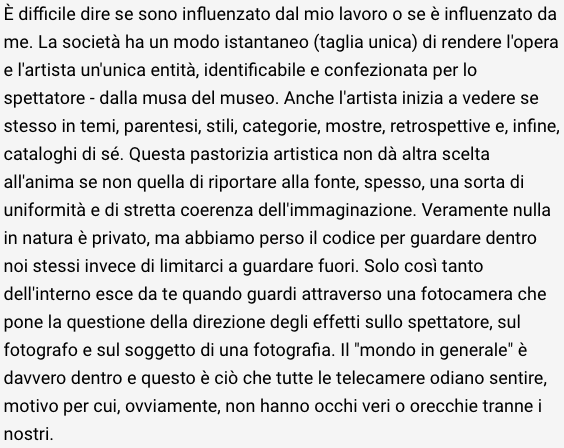
- Pensi che quello che stai facendo avrà dei risvolti concettuali ed operativi che resteranno dentro allo sviluppo del tuo lavoro artistico e in quali termini o sarà solo una parentesi?
It is impossible to subtract an aesthetic practice or aesthetic knowledge once it has been put in place, firmly inserted into an individual’s temperament (isn’t that how self-programming works?) but art does have a way of creating objects that echo and become tradition and, sadly, deities within the parenthesis of a body of work and the body almost never forgets or escapes this (style worship) and if an artist is lucky enough matures (in nature), the body will at least lock itself in a life-long battle with such solidity because, after all, what is the artist but a storehouse of operational expressions held together by the multiple agreements of an organic anxiety. This is truer of the painter than the photographer and in the last century, whenever that was, it was truer of the poet than the dramatist. Each artist, to continue an artist, has to become the sum of all of the artists before him or her, before the word artist took root in him or her, before the ending began. When you leave the darkroom (and we have), the developing starts again, blindingly so!
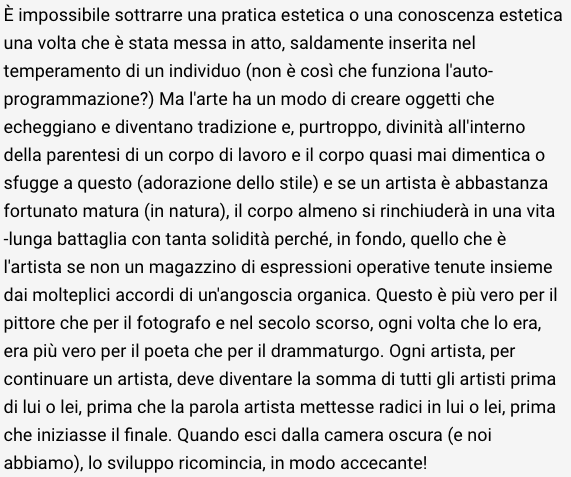
Thomas Sayers Ellis è nato a Washington, DC nel 1963. Ha studiato poesia con Seamus Heaney all’Università di Harvard dove ha lavorato come guardia di sicurezza e proiezionista presso il Carpenter Center for Visual and Environmental Studies di Le Corbusier e su suggerimento di Heaney, ha conseguito il suo MFA in Scrittura Creativa presso la Brown University (1993-95) sotto la guida del poeta Michael S. Harper.
E’ autore di The Maverick Room, Skin, Inc: Identity Repair Poems e The Corny Toys e ha ricevuto una Guggenheim Fellowship for Poetry nel 2015. Le sue poesie e fotografie sono apparse in numerosi documentari, su copertine di libri, in riviste e antologie, tra cui The Best American Poetry (1997, 2001, 2010, 2015), The Paris Review e The Nation.
La sua prima mostra personale è stata “(Un) Lock It: the Percussive People in the GoGo Pocket” (la Gallery at Vivid Solutions, Washington, DC, 2011) ed è apparso in “DC As I See It” (Leica Gallery, Washington , DC 2013). Nel 2013 ha ricevuto una borsa di studio da Project Row Houses (Houston, Texas) per la mostra “The Self Offense of Black Self Defense”. Nel 2014, ha co-fondato (con il sassofonista James Brandon Lewis) Heroes Are Gang Leaders, un ensemble di musicisti e poeti noti per il free jazz letterario. Nel 2018, HAGL ha ricevuto l’American Book Award for Oral Literature e nel 2020 HAGL ha pubblicato il suo quinto CD, Artificial Happiness Button (Ropeadope Records).
Ellis, attualmente, scrive una rubrica mensile sulla fotografia e la poesia per Arrowsmith Press https://www.arrowsmithpress.com/journal.
